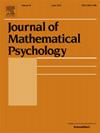A computational account of self-control
IF 1.5
4区 心理学
Q2 MATHEMATICS, INTERDISCIPLINARY APPLICATIONS
引用次数: 0
Abstract
Self-control is core to human well-being. However, the lack of a well-specified, computationally tractable framework related to self-control makes it difficult to clarify underlying mechanisms, interpret relevant empirical phenomena, or develop interventions helpful in promoting self-control. To help address this gap, we invite consideration of the Comparison with Goal States Model (CGSM) for self-control. The CGSM amplifies activations related to available options whose representations are similar to representations of relevant goals and diminishes activations related to available options whose representations are dissimilar to representations of relevant goals. For example, influenced by healthy eating goals, the CGSM would amplify activations related to an apple and diminish activations related to a cookie, leading to an eventual preference for the apple, even though the cookie might be initially preferred. The CGSM successfully explicates observations related to reaction time in food choice, dynamics reflected in mouse-tracking trajectories, and showcases a mechanism by which hyperbolic discount curves in temporal discounting contexts might emerge. We use the CGSM to propose theoretical constraints on the nature of self-control and describe how multiple strategies have the potential to promote self-control.
自我控制的计算方法
自我控制是人类福祉的核心。然而,由于缺乏一个与自我控制相关的、规范的、可计算的框架,因此很难阐明其背后的机制、解释相关的经验现象或制定有助于促进自我控制的干预措施。为了帮助弥补这一不足,我们邀请大家考虑自控力的目标状态比较模型(CGSM)。如果可选方案的表征与相关目标的表征相似,那么目标状态比较模型就会放大与可选方案相关的激活,而如果可选方案的表征与相关目标的表征不相似,那么目标状态比较模型就会减弱与可选方案相关的激活。例如,受健康饮食目标的影响,CGSM 会放大与苹果相关的激活,而减弱与饼干相关的激活,从而导致最终偏好苹果,尽管最初可能偏好饼干。CGSM 成功地解释了与食物选择中的反应时间相关的观察结果、反映在小鼠追踪轨迹中的动态变化,并展示了在时间折现情境中可能出现双曲线折现曲线的机制。我们利用 CGSM 对自我控制的本质提出了理论约束,并描述了多种策略如何有可能促进自我控制。
本文章由计算机程序翻译,如有差异,请以英文原文为准。
求助全文
约1分钟内获得全文
求助全文
来源期刊

Journal of Mathematical Psychology
医学-数学跨学科应用
CiteScore
3.70
自引率
11.10%
发文量
37
审稿时长
20.2 weeks
期刊介绍:
The Journal of Mathematical Psychology includes articles, monographs and reviews, notes and commentaries, and book reviews in all areas of mathematical psychology. Empirical and theoretical contributions are equally welcome.
Areas of special interest include, but are not limited to, fundamental measurement and psychological process models, such as those based upon neural network or information processing concepts. A partial listing of substantive areas covered include sensation and perception, psychophysics, learning and memory, problem solving, judgment and decision-making, and motivation.
The Journal of Mathematical Psychology is affiliated with the Society for Mathematical Psychology.
Research Areas include:
• Models for sensation and perception, learning, memory and thinking
• Fundamental measurement and scaling
• Decision making
• Neural modeling and networks
• Psychophysics and signal detection
• Neuropsychological theories
• Psycholinguistics
• Motivational dynamics
• Animal behavior
• Psychometric theory
 求助内容:
求助内容: 应助结果提醒方式:
应助结果提醒方式:


